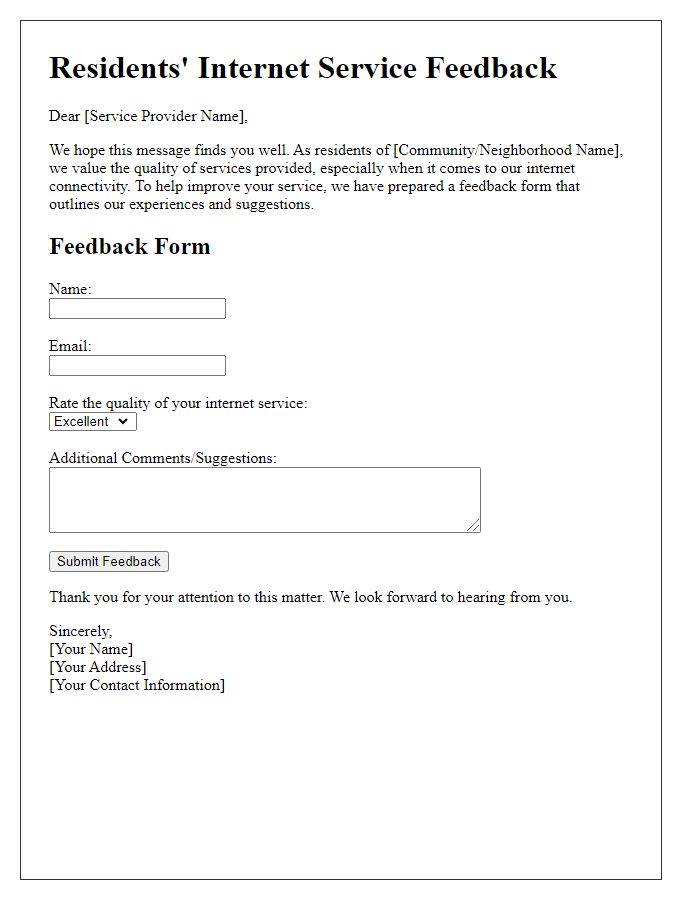Hey there, tenants! We're excited to hear your thoughts on your internet service preferences so we can ensure you have the best connectivity experience possible in your home. This survey is a chance for you to voice what matters most to youâbe it speed, reliability, or pricing. Your feedback is invaluable, so let's get started and shape our community together!

Survey Purpose and Objective
A tenant internet service preference survey aims to gather insights into the specific internet connectivity needs of residents within apartment complexes, such as Brookstone Apartments located at 1234 Maple Avenue. The objective includes identifying preferred internet service providers, desired connection speeds (ranging from 100 Mbps to 1 Gbps), and essential features like unlimited data plans or customer support responsiveness. Understanding these preferences helps property management improve overall tenant satisfaction and retention rates, ensuring that residents are equipped with reliable and efficient internet access for remote work, streaming, and online education needs.
Potential Internet Service Providers
Conducting a tenant internet service preference survey reveals insights into connectivity needs for residents in multifamily housing communities. This survey focuses on potential Internet Service Providers (ISPs) available in urban areas, such as Comcast Xfinity, AT&T Fiber, and Spectrum. Each ISP offers various packages with diverse speed options ranging from 100 Mbps to 1 Gbps, catering to different user needs for activities like streaming, online gaming, and remote work. Additionally, understanding preferences for contract lengths, installation fees, and customer support options can improve tenant satisfaction and guide property management decisions. Collecting responses will ensure that chosen ISP aligns with the interests of diverse residents, helping establish a robust and reliable internet infrastructure in the building.
Preferences for Speed and Bandwidth
High-speed internet connectivity plays a crucial role in enhancing the digital experience for tenants in residential buildings. Internet speed, measured in megabits per second (Mbps), influences streaming capabilities, online gaming responsiveness, and multiple device connectivity. Bandwidth capacity ensures seamless use of applications requiring substantial data transfer, like video conferencing or large file downloads. Tenants might prefer speed tiers ranging from 100 Mbps for casual browsing to 1 Gbps for intensive usage in places like urban apartments, where multiple users might simultaneously stream high-definition content. Understanding these preferences can facilitate tailored internet service offerings, leading to improved satisfaction and convenience for residents.
Equipment and Installation Requirements
Conducting a tenant internet service preference survey is essential for understanding the specific Equipment and Installation Requirements needed for optimal connectivity in multi-dwelling units. High-speed internet access, typically offered through fiber optic cables or cable broadband, often necessitates unique installation setups, such as wall-mounted routers and properly placed Ethernet ports. Tenants may require additional equipment like Wi-Fi extenders or mesh networks to enhance coverage in larger apartments or areas with significant obstacles. Furthermore, installation preferences can vary significantly, including professional tech installations versus self-install kits, with timeframes often spanning from a few hours to several days based on the complexity. Utilities, such as power outlets proximity and existing infrastructure compatibility, significantly influence the installation process. Gathering detailed insights through this survey helps in tailoring internet service solutions that best meet tenant needs.
Tenant Feedback and Suggestions
Tenant feedback on internet service preferences is crucial for optimizing connectivity and ensuring satisfaction within residential complexes. Understanding specific needs, such as preferred internet service providers like Comcast or AT&T, download and upload speed requirements, along with pricing considerations, helps tailor services to individual tenant preferences. Exploring options for bundled services (internet, cable, and phone) can also enhance overall satisfaction. Additionally, gathering feedback on existing service reliability, customer support experiences, and any areas for improvement, contributes to a more robust solution that addresses tenant needs. Such insights pave the way for informed decisions regarding future internet service contracts or upgrades in housing developments.













Comments